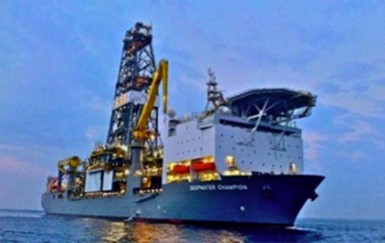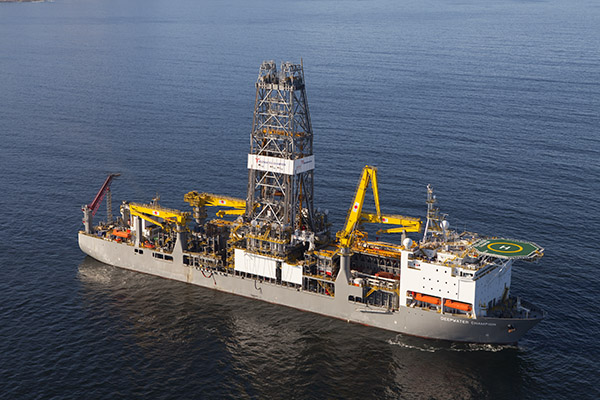A decades-long search for hydrocarbons offshore Guyana has finally yielded success with Exxon Mobil Corporation yesterday reporting a “significant oil discovery”.
The company stated that the Liza-1 well was drilled by ExxonMobil affiliate, Esso Exploration and Production Guyana Ltd and “encountered more than 295 feet (90 meters) of high-quality oil-bearing sandstone reservoirs.”

Media Relations Advisor Aaron Stryk told Stabroek News that it would take several months for the evaluation process. He said that while the find is encouraging he could not give any specific timelines as to when the evaluation process would yield results, noting that revenue potential was years away.
Stryk told this newspaper that as of now very little is known and extensive data collection has already commenced. He said that the first data would be gathered to determine commercial viability, followed by the planning and management of the development process.
He said that all agreements are being fostered under a licensing agreement with the Government of Guyana. It was announced yesterday by President David Granger that the Ministry of the Presidency will be responsible for Natural Resources, effectively disposing of the stand-alone Ministry of Natural Resources and the Environment that was previously created in 2011 under former President Donald Ramotar’s administration.
Granger emphasised yesterday, after the swearing in of Prime Minister Moses Nagamootoo and cabinet ministers, that the inclusion of natural resources under the helm of the Ministry of the Presidency was to ensure accountability of the sector. He stated that there would be no single minister charged with the responsibility of the sector which would allow for greater transparency of communal resources.
ExxonMobil had remained mum on the outcome of the well until yesterday. Members of the former administration including Natural Resources Minister, Robert Persaud and the People’s Progressive Party had however played up an announcement just days before the May 11th General Elections that hydrocarbons were found in the well even though it was stated then that the scale of the discovery still had to be assessed.
The party utilized the potential discovery for its campaign which resulted in full-page advertisements taken out in the daily newspapers in the days leading up to the elections.
In recent years, both the Canadian and American Governments have been paying keen attention to the strides being made by Guyana in oil exploration with the intention of helping to create a transparent framework to account for revenues from any oil and gas find.
The draft Guyana National Upstream Oil and Gas Policy was accepted by Cabinet in November 2014. The draft legislation will need to be taken up by the new government.
Currently, Guyana’s Constitution does not make provisions for the ownership of petroleum resources, this is according to the Guyana Policy Discussion report in conjunction with the Commonwealth. The Upstream Oil and Gas Policy framework aims to improve institutions’ capacity to govern oil and gas operations with strategic plans for the extraction of petroleum resources by reforming legislation.
The draft policy addresses the need to modernise licensing agreements with oil and gas operations as well as tackles the issue of land ownership and management. Most recently the US Government held a Planning and Oversight Deepwater Training under the Energy Governance and Capacity Initiative (EGCI) in April for members of the Environmental Protection Agency and the Guyana Geology and Mines Commission.
The EGCI is slated as one of the entities to assist in the establishment of governing options for the country. Guyana is considering the establishment of a sovereign wealth fund as part of its strategy to manage revenues that could accrue from its oil and gas potential.
The Natural Resources Ministry had recently engaged the Bureau of Energy Resources of the US Department of State to further assist Guyana in the development of its technical capacity in the oil and gas sector.
Chargé d’Affaires at the US Embassy, Bryan Hunt warned at the EGCI forum of the propensity for corruption in the oil and gas sector within emerging economies while congratulating Guyana on taking proactive steps toward the development of the sector. The training was focused mainly on the technical aspects but the larger picture was to allow for the transition from oil and gas exploration to discovery to the creation of revenue while not squandering resources.
In June of last year a team from the Natural Resources Ministry along with Dr. Nicole Giles, High Commissioner of Canada to Guyana travelled to the oil rich Canadian province of Alberta for several meetings which focused on improving the technical capacity of Guyana for natural resources development.
Controversy
ExxonMobil’s commitment to Guyana has not been without controversy. Venezuela has issued multiple objections, the first in February, prior to the Deep Water Champion Oil Exploration Rig commencing exploration on March 5. The Venezuelan Foreign Minister Delcy Rodríguez wrote the company’s Country Manager Jeff Simon accusing the firm of violating international laws.
“…your communication and actions openly contradict the due respect towards Public International Law and the Bolivarian Republic of Venezuela, clearly showing your intention to subvert it, since privately and unilaterally you intend to perform unauthorised operations in a vast offshore space adjacent to our energy reserves in the so-called Stabroek block, which the Bolivarian Republic of Venezuela has not recognized, now or in the past,” she wrote in a letter dated April 7, 2015.
She said that when Caracas protested similar exploration activity on August 10, 1993 and July 13, 1999, the company did not go ahead with exploration activities but is doing so now. The Venezuelan Foreign Affairs minister said that the situation cannot be decontextualized from the recent and “extraordinary” action of the US government that declared Venezuela to be “an unusual and extraordinary threat to its internal security and foreign policy,” which, according to Rodriguez “is disassociated but not unrelated to the hegemonic interests over the proven international reserves that are adjacent to the area in which you intend to operate.”
The ExxonMobil Liza-1 well was safety drilled to 17,825 feet in 5,719 feet of water. The entire Stabroek Block is 26,800 square kilometres. According to ExxonMobil, Esso Exploration and Production Guyana Ltd owns 45 percent interest while Hess Guyana Exploration Limited holds 30 percent interest and CBOOC Nexen Petroleum Guyana Ltd owns the remaining 25 percent.
The cost of drilling the well has not been announced. Any oil extracted from the well would be governed by a production sharing agreement between the company and the Guyana Government.





